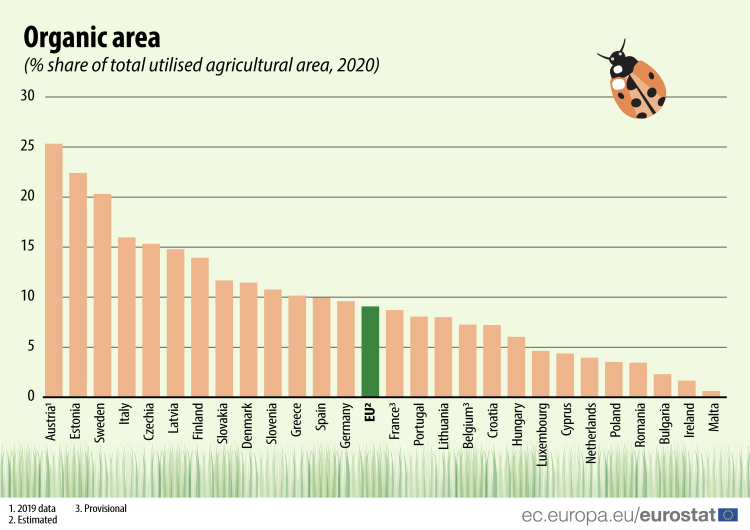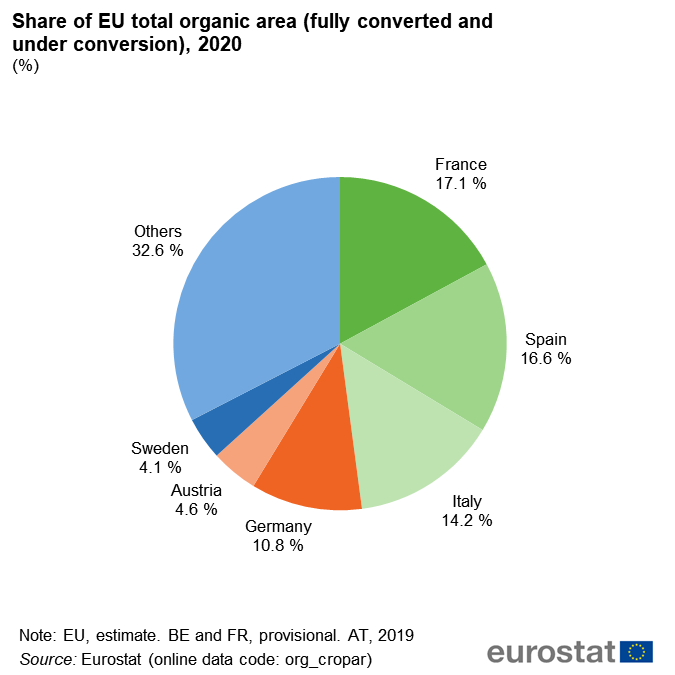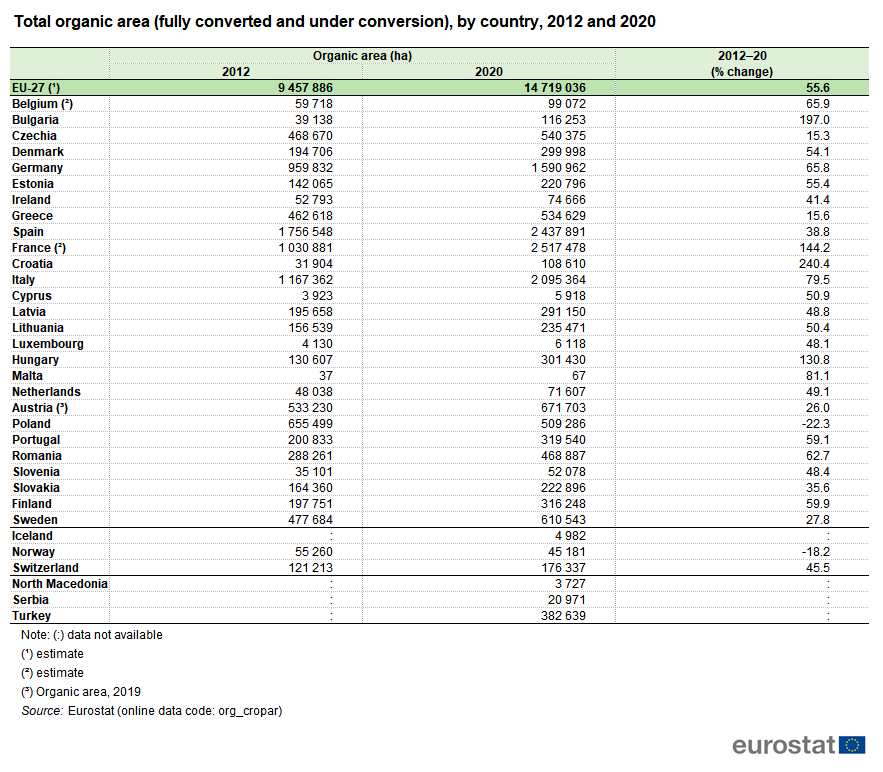EU ORGANIC FARMING HAS GROWN TO COVER 9% OF AGRICULTURAL AREAS
Data from the European Union’s statistics arm, Eurostat, show that organic farming covers around 14.7 million hectares of agricultural land in the EU, corresponding to 9.1% of the total utilised agricultural area (UAA) in the bloc, up from 5.9% in 2012.
The share, based on 2020 measurements, represents a steep rise from the 9.5 million hectares used for organic agricultural production in 2012, a 56% uplift. Between 2012 and 2020, the share of the agricultural area used for organic farming increased in all EU member states except for Poland. There, the organic farming area declined by a staggering 22%, making it the only country to go backwards.
The countries with the highest shares of organic farming areas in 2020 were Austria with 25%, Estonia (22%) and Sweden (20%). Italy, Czech Republic, Latvia, Finland, Slovakia, Denmark, Slovenia and Greece had shares above 10%. The least organic countries in order were Malta, Ireland, and Bulgaria at well below 5%.

According to the data, there tend to be higher rates of organic grazing livestock than for other livestock. For example, just over one-third (36%) of sheep and goats in both Latvia and Austria were raised according to organic farming methods. Likewise, just under one-third (30%) of bovine animals in Greece were organic. However, rates were much lower for pigs, the highest share being in Denmark (3.4%).
Age matters
Interestingly, but no surprise, is that managers of organic farm holdings tend to be younger than their non-organic counterparts. The share of farm managers under 40 years of age was twice as large for organic farms at 21% as for non-organic farms (10.5%).
Organic areas in the EU states are the sum of areas under conversion to organic farming and existing certified areas. Before an area can be certified as organic it must undergo a conversion process, which may take 2-3 years depending on the crop.

By area, France had the most space within the EU dedicated to organic agricultural production in 2020 at 2.5 million hectares of land which was almost 1.5 times more than the equivalent area in 2012. Spain with 2.4 million hectares and Italy with 2.1 million hectares were the only other countries with more than 2 million hectares of land area used for organic agriculture.
By share, these three countries, plus Germany, accounted for well over half (59%) of the EU’s total organic area in 2020. The share splits were France (17.1%), Spain (16.6%), Italy (14.2%) and Germany (10.8%).
Crops certification
In all EU member states, it is organic crop areas that were mainly certified. In 2020, in eight states (Lithuania, Netherlands, Czech Republic, Sweden, Ireland, Estonia, Latvia and Luxembourg), more than 90% of organic crop areas were reported as certified. Another 14 countries had shares of ‘certified organic’ at between 70% and 90%.

The lowest shares of certified areas were recorded for Hungary (64.1%), Malta (61.2%) and Romania (58.9%), which means there is a high potential for further growth in certified areas in these countries in the coming years. Due to the 2-3 years conversion period of agricultural land, a high share of area under conversion is necessary to avoid stagnation in the growth of the certified organic area.
Sweden had the largest share of organic production of cereals and fresh vegetables in 2020. In 2020, organic production of cereals accounted for 7.1% of total cereals production in Sweden, 6.1% in Estonia, followed by Italy with 5.8%.
Sweden also had the largest share of organic fresh vegetable production at 17.8%, followed by Germany (10.4%), and Italy (8.3%). In the remaining EU states the share of organic production for vegetables ranged from almost an almost negligible 0.05% in Malta, to 5.7% in the Netherlands.
Arable land – mainly cereals, root crops, fresh vegetables, green fodder and industrial crops – represented almost half (46%) of the EU’s total organic agricultural area in 2020 at 6.8 million hectares in 2020. The rest was divided between permanent grassland (pastures and meadows) at 42%, and permanent crops (fruit trees and berries, olive groves and vineyards) making up the rest. Organic pastures and meadows are mostly used for grazing organic livestock.
In 11 EU countries, organic arable crops accounted for more than half of their total organic agricultural area, whilst in 13 member states organic pastures and meadows covered more than half of their total organic agricultural area. Countries with the highest organic arable crop areas were Finland (99.2%), Denmark (82.8%) and Sweden (77.2%) whereas organic pastures and meadows dominated in Ireland (89%), Czech Republic (82%) and Slovenia (80.5%).
Join us at SIAL Paris as exhibitor Join us at SIAL Paris as visitor
